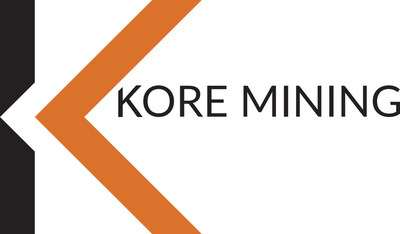Drilling High Priority Targets at Long Valley and Imperial for New Discoveries and Resource Growth
VANCOUVER, BC, Feb. 3, 2021 /PRNewswire/ – KORE Mining Ltd. (TSXV: KORE) (OTCQX: KOREF) («KORE» or the «Company«) is pleased to announce plans for systematic 2021 exploration at both the Imperial Gold project («Imperial») and the Long Valley Gold project («Long Valley») where successful 2020 target generation programs identified an array of resource growth and new discovery drill targets. Both Imperial and Long Valley, have district scale potential with over 26,000 and 16,000 hectares of claims respectively, are 100% owned, and have no royalties on a majority of claims.
Imperial Exploration Work Program and Milestones
- Soil sampling and mapping results from Imperial to Picacho expected in March 2021
- Detailed soil sampling around initial gold anomalies for Mesquite-Imperial in Q1 2021
- Infill IP geophysics from Mesquite (Equinox – EQX:TSX, EQX:NYSE) to Imperial in H1 2021
- First pass IP geophysics between Imperial and Picacho in H1 2021
- Permits for drilling to expand resources and make new discoveries expected in mid-2021
- Low-cost drilling to test shallow, high priority new discovery targets planned in H2 2021
Long Valley Exploration Work Program and Milestones
- Permit for resource growth drill program expected in Q1 2021
- Drilling shallow gold resource expansion and high-grade underlying sulphide targets in mid-2021
- Mapping and sampling newly staked 16,000 hectare land package to identify new gold targets
- Follow-up IP geophysics to define fault structures on new gold anomalies in H2 2021
Scott Trebilcock, CEO of KORE states, «KORE is focused on exploration growth in its US assets after delivering value across the portfolio in 2020. Shareholders can look forward to value creation from low-cost exploration. Both projects have shallow well defined resources with high return preliminary economic assessments and have a multitude of resource expansion targets defined from their 2020 field work. In addition, KORE controls the entire gold district around Imperial and a large claim area around Long Valley. Both areas have shallow, high priority drill targets to make new discoveries with low-cost scout drilling programs.»
Mr. Trebilcock continues, «In parallel with growth by exploration, KORE will continue to advance Imperial towards a production decision. KORE is on a path to be a mid-tier gold producer, with up to 350,000 ounces of gold per annum of production between Imperial and Long Valley combined.»
KORE is prepping its highest priority targets and is anticipating updates as the Company’s exploration team confirms next steps in the coming weeks.
Imperial Exploration Details
Imperial has a mineral resource estimate with a positive Preliminary Economic Assessment («PEA»), released April 6, 2020, having the following highlights:
- Robust economics: C$ 642 million NPV5%* post-tax with 52% IRR at US$1,600 per ounce gold
- Low capital intensity project with only US$ 143 million pre-production capital cost
- 146,000 ounces gold per year over 8 years for 1.2 million ounces total production; and
- Technically simple project: shallow open pit, run-of-mine heap leach with existing infrastructure.
KORE is pursuing value enhancement over the PEA through resource expansion and exploring the Mesquite-Imperial-Picacho District (the «District»), a 28 km gold trend centered on Imperial. The three main deposits – Mesquite, Imperial and Picacho – were all discovered by outcrop, while the remainder of the District is under alluvial cover and is largely unexplored. Figure 1 shows the Mesquite-Imperial-Picacho District claims.
KORE is using IP geophysics to interpret controlling fault structures that host mineralization in the District’s deposits and look under the alluvial cover. Soil sampling from dry riverbeds (arroyos) is being used to further prioritize drill targets on the fault structures.
First past IP was completed in H1 2020, first over the Imperial deposit and then stepping out toward Mesquite. Having the intact Imperial deposit to «tune» or «fingerprint» the geophysical signatures, greatly enhances the confidence to target new discoveries under the alluvium along the trend. Details of the work were released January 7, 2020 and April 29, 2020. Interpreted faults traced were traced continuously from Mesquite to Imperial.
KORE followed up the IP geophysics in H2 2020 with mapping and first pass soil sampling for the entire 28 km Mesquite-Imperial-Picacho trend to further define discrete drill targets, which was completed as recently as this past weekend. Results from the Imperial-Mesquite portion of the District were released December 8, 2020. Figure 2 depicts the western half of the District (Mesquite-Imperial) with three large exploration areas – Mesquite East, Ogilby and Imperial West. Samples from the Imperial area are at the lab and samples from Imperial-Picacho are being prepared for the lab. Results are expected in several batches through Q1 2021.
KORE plans to follow-up on the identified soil anomalies with further detailed soil sampling grids and infill geophysical surveys in H1 2021.
KORE is currently permitting a 168 pad drill program via a Plan of Operations («PO») process with the Bureau of Land Management local office. Permits are expected in mid-2021. Drill testing of the highest priority targets is planned to start in H2 2021, subject to permitting.
Long Valley Exploration Details
Long Valley has a mineral resource estimate with a positive PEA, released October 27, 2020, having the following highlights:
- Robust economics: C$ 376 million NPV5%* post-tax with 48% IRR at US$1,600 per ounce gold
- 102,000 ounces gold per year over 7 years for 0.7 million ounces total production; and
- Technically simple project: shallow open pit, heap leach with nearby infrastructure.
Long Valley’s shallow mineralization has an array step-out drill targets in all directions. The project can be further expanded with new discoveries on the recently staked claims, see release dated December 1, 2020 and as depicted in Figure 3, that have the potential to host parallel mineralized structures, similar to the one that hosts the current resources. Additional mineralization could extend mine life, reduce capital intensity, and generate higher project economic returns modelled in the positive PEA. An summary of oxide expansion targets is included in Figure 4.
Additionally, as a fully intact epithermal deposit with a large at surface footprint, Long Valley has the potential for high-grade sulphides in the underlying feeder structures. Discovering high-grade sulphides would open up additional development pathways for Long Valley, such as underground mining. A summary of sulphide expansion targets, interpreted feeder structures, is included in the KORE news releases dated January 30, 2020 and March 24, 2020.
KORE is currently permitting a drill program at Long Valley. The permit has been in process since mid-2020 and permits are expected in Q1 2021.
KORE plans a low-cost drill program to test the highest priority oxide and sulphide targets in 2021. Drilling planned for mid-2021, subject to the US Forest Service permitting timelines and permit conditions.
KORE is also planning an IP geophysics survey in H2 2021 to define new structures on the recently staked claims on which to target new discoveries.
KORE is committed to operate within the stringent environmental and labour standards of California. KORE plans to concurrently reclaim drill pad locations and ensure measures are taken to mitigate any impacts to biological and cultural resources. KORE has designed the drill programs to maximize the existing public road/trail network in the area so as to limit any new disturbances, and the Company will be adjusting our drill pad locations as needed to avoid any sensitive sites should any be encountered.
About Imperial Gold Project
KORE owns 100% of the Mesquite-Imperial-Picacho District which consists of 26,323 acres on 1,007 claims capturing the entire 28-kilometer trend from the operating Mesquite mine (Equinox Gold – TSX:EQX) to the closed Picacho mine and including KORE’s Imperial project as depicted on Figure 1. The Imperial resource, which was the subject of a highly successful 2020 Preliminary Economic Assessment released April 6, 2020, is located roughly in the center of the District. KORE is planning to move the Imperial PEA mine plan into permitting in mid-2021 once they have received drilling permits.
In the District, gold is hosted in local fault structures related to a series of regional faults connecting the known District deposits. Those three District deposits (Mesquite-Imperial-Picacho) were discovered in exposed outcrops and from placer workings. The rest of the District is covered by alluvium and has never been systematically explored using modern techniques.
Imperial is a structurally controlled intermediate sulfidation epithermal gold deposit. The 100% oxide gold deposit is currently defined at 2.44 kilometer long and up to 0.75 kilometer wide and is open both along strike and downdip. It is hosted in a shallowly southwest dipping, amphibolite grade metamorphic rock suite along a west-northwest trending low-angle regional thrust fault system. The thrust fault system controls the regional geometry of mineralization. East-west striking, post-mineralization normal faults control the property scale geometry of mineralization. Geophysical characterization of the deposit and regional controlling structures is an essential component of exploration for additional resources.
About Long Valley Project
Long Valley is 100% owned epithermal gold project located in Mono County California as depicted in Figure 3. The Long Valley deposit is an intact epithermal gold deposit with a large 2.5 km by 2 km oxide gold footprint. The deposit was the subject of a highly successful PEA released October 27, 2020.
The Long Valley deposit is an intact low sulphidation epithermal gold/silver deposit, hosted within a melange of fine to coarse volcanogenic sedimentary lithologies. Mineralization at Long Valley has developed due to a combination of deep-rooted fault structures and a resurgence of rhyolite within an active caldera. The Hilton Creek Fault structure transects and served as a fluid conduit for interaction with the underlying hydrothermal system, while the rhyolite resurgence caused brittle fracturing of sediments and created voids or traps for mineralization and gold deposition. The combination of these factors yields strongly altered kaolin and quartz-hematite zones that are the primary host for gold mineralization.
The Hilton Creek Fault remains underexplored on-strike north and south and several parallel structures have been defined using geophysics, the eastern one hosting some of the current mineral resource and the western one being unexplored. Long Valley is therefore open to new oxide discoveries in all directions.
|
* Conversion of the NPV 5% for Imperial and Long Valley at C$1,600 gold uses 0.7 US$ per $C. |
About KORE Mining
KORE is 100% owner of the Imperial and Long Valley gold projects assets in California. Both projects have positive economic assessments put KORE on the path to up to 350,000 ounces of gold production. KORE is supported by strategic investor Eric Sprott who owns 26% of KORE’s basic shares. KORE management and Board are aligned with shareholders, owning an additional 38% of the basic shares outstanding. KORE is actively developing its Imperial Gold project and is aggressively exploring across its portfolio of assets.
Further information on Imperial and KORE can be found on the Company’s website at www.koremining.com or by contacting us as info@koremining.com or by telephone at (888) 407-5450.
On behalf of KORE Mining Ltd
«Scott Trebilcock»
Chief Executive Officer
(888) 407-5450
Investor Relations
Arlen Hansen, KIN Communications
1-888-684-6730
kore@kincommunications.com
Technical information with respect to the Imperial Gold Project and Long Valley Project contained in this news release has been reviewed and approved by Marc Leduc, P.Eng, who is KORE’s COO and is the qualified person under National Instrument 43-101 responsible for the technical matters of this news release.
Neither the TSX Venture Exchange nor its Regulation Services Provider (as that term is defined in the policies of the TSX Venture Exchange) accepts responsibility for the adequacy or accuracy of this release.
Cautionary Statement Regarding Forward-Looking Information
This news release contains forward-looking statements relating to the future operations of the Company and other statements that are not historical facts. Forward-looking statements are often identified by terms such as «will», «may», «should», «anticipate», «expects», «intends», «indicates» and similar expressions. All statements other than statements of historical fact, included in this release, including, without limitation, statements regarding the future plans and objectives of the Company are forward-looking statements. Forward-looking statements in this news release include, but are not limited to, statements with respect to: final results of future exploration work, including further mapping and sampling and the timeline for completion, the results of thePEAs for both the Imperial and Long Valley projects, including future opportunities, , the projected NPV for both the Imperial and Long Valley projects, permit timelines, and the ability to obtain the requisite permits, the market and future price of and demand for gold, , and the ongoing ability to work cooperatively with stakeholders, including the all levels of government. Such forward-looking statements, and any assumptions upon which they are based, are made in good faith and reflect our current judgment regarding the direction of our business. Management believes that these assumptions are reasonable. Forward looking information involves known and unknown risks, uncertainties and other factors which may cause the actual results, performance or achievements of the Company to be materially different from any future results, performance or achievements expressed or implied by the forward-looking information.
Such factors include, among others: risks related to exploration and development activities at the Company’s projects, and factors relating to whether or not mineralization extraction will be commercially viable; risks related to mining operations and the hazards and risks normally encountered in the exploration, development and production of minerals, such as unusual and unexpected geological formations, rock falls, seismic activity, flooding and other conditions involved in the extraction and removal of materials; uncertainties regarding regulatory matters, including obtaining permits and complying with laws and regulations governing exploration, development, production, taxes, labour standards, occupational health, waste disposal, toxic substances, land use, environmental protection, site safety and other matters, and the potential for existing laws and regulations to be amended or more stringently implemented by the relevant authorities; uncertainties regarding estimating mineral resources, which estimates may require revision (either up or down) based on actual production experience; risks relating to fluctuating metals prices and the ability to operate the Company’s projects at a profit in the event of declining metals prices and the need to reassess feasibility of a particular project that estimated resources will be recovered or that they will be recovered at the rates estimated; risks related to title to the Company’s properties, including the risk that the Company’s title may be challenged or impugned by third parties; the ability of the Company to access necessary resources, including mining equipment and crews, on a timely basis and at reasonable cost; competition within the mining industry for the discovery and acquisition of properties from other mining companies, many of which have greater financial, technical and other resources than the Company, for, among other things, the acquisition of mineral claims, leases and other mineral interests as well as for the recruitment and retention of qualified employees and other personnel; access to suitable infrastructure, such as roads, energy and water supplies in the vicinity of the Company’s properties; and risks related to the stage of the Company’s development, including risks relating to limited financial resources, limited availability of additional financing and potential dilution to existing shareholders; reliance on its management and key personnel; inability to obtain adequate or any insurance; exposure to litigation or similar claims; currently unprofitable operations; risks regarding the ability of the Company and its management to manage growth; and potential conflicts of interest.
In addition to the above summary, additional risks and uncertainties are described in the «Risks» section of the Company’s management discussion and analysis for the year ended December 31, 2019 prepared as of April 27, 2020 available under the Company’s issuer profile on www.sedar.com.
Forward-looking statements contained herein are made as of the date of this news release and the Company disclaims any obligation to update any forward-looking statements, whether as a result of new information, future events or results, except as may be required by applicable securities laws. There can be no assurance that forward-looking information will prove to be accurate, as actual results and future events could differ materially from those anticipated in such statements. Accordingly, readers should not place undue reliance on forward-looking information.
There is no certainty that all or any part of the mineral resource will be converted into mineral reserve. It is uncertain if further exploration will allow improving the classification of the Indicated or Inferred mineral resource. Mineral resources are not mineral reserves and do not have demonstrated economic viability.
![]() View original content to download multimedia:http://www.prnewswire.com/news-releases/kore-mining-focused-on-advanced-us-gold-projects-for-growth-in-2021-301220895.html
View original content to download multimedia:http://www.prnewswire.com/news-releases/kore-mining-focused-on-advanced-us-gold-projects-for-growth-in-2021-301220895.html
SOURCE Kore Mining






